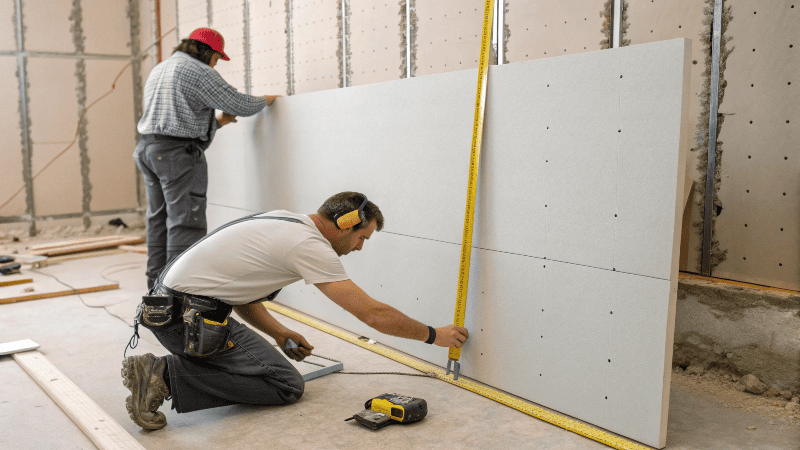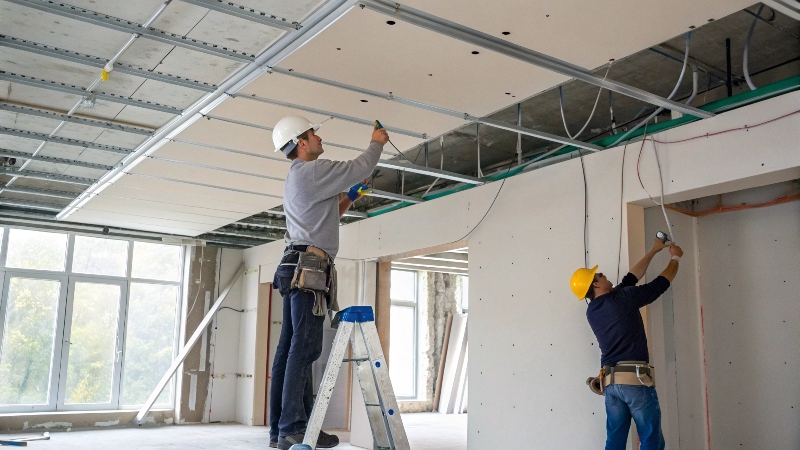What is the best thickness of gypsum board for ceilings?
Many people get ceiling drywall wrong. They either pick the thickest board thinking it's best or go thin to save money. Both can cause problems.
The best thickness of gypsum board for most ceilings is 12.5mm (1/2 inch), as it offers a strong balance of durability, weight, and cost for standard residential applications.
When choosing ceiling gypsum board, thickness matters. The right choice depends on joist spacing, ceiling span, and load requirements. A wrong choice can lead to sagging, cracks, or extra costs later.
Is half inch or 5/8 drywall better for ceilings?
Some believe thicker boards always work better. Others think thinner boards are easier and cheaper. Both views miss key details.
1/2 inch boards work well for ceilings with joists spaced 400–600mm apart, while 5/8 inch boards perform better for larger spans or higher soundproofing needs.
I often find this question comes from homeowners starting renovations. 12.5mm (1/2 inch) is easier to handle and suits most living rooms, bedrooms, or kitchen ceilings. It's lighter but still strong when installed correctly.
15mm (5/8 inch) offers better stiffness. In larger rooms with joist spacing close to 600mm, it resists sagging. It also improves sound insulation, which is good for home theaters or commercial offices.
| Feature | 1/2 inch (12.5mm) | 5/8 inch (15mm) |
|---|---|---|
| Weight | Lighter | Heavier |
| Best for | Small to medium ceilings | Large or long-span ceilings |
| Soundproofing | Standard | Better |
| Sag resistance | Good for tight joists | Excellent |
In my work, I follow a simple rule: use 1/2 inch unless the ceiling is wide, or unless a client requests extra sound control or commercial-grade durability.
Is 9mm gypsum board good for ceilings?
Some choose 9mm to save money or reduce weight. This can be risky.
9mm gypsum board is not ideal for standard ceilings and should only be used in small areas with dense framing or decorative drops.
I remember a client who used 9mm boards in a living room with 600mm framing spacing. At first, it looked fine. But in six months, it sagged badly and developed cracks at joints. We later replaced it with 12.5mm, adding more framing. The cost ended up much higher.
9mm is lighter and easy to cut, which makes it good for decorative ceiling shapes or short spans within tight spacing like 300mm. But for normal spacing, it lacks stiffness. Heat and humidity make it worse. Over time, it cannot hold its shape well.
| Factor | 9mm Board | 12.5mm Board |
|---|---|---|
| Strength | Low | Medium |
| Cost | Lower | Reasonable |
| Recommended span | Very short | Medium span |
| Risk of sag | High | Low |
For any main ceiling area, I move clients toward at least 12.5mm, even if their first goal is to save cost.
Is 1/2 drywall ok for ceilings?
People often ask if 1/2 inch sheet can handle ceilings long-term.
Yes, 1/2 inch drywall is okay for ceilings when framing spacing is no more than 400–600mm, but it must be installed correctly to prevent sagging.
From my own experience, 1/2 inch gypsum board is the sweet spot for home ceilings. It is easy to lift and cut. It sits well between joists at the standard residential spacing. The key is correct screw spacing and avoiding moisture problems.
Still, in rooms larger than 5 meters across or with heavy insulation above, 5/8 inch boards provide peace of mind. That extra stiffness makes them straighter and more stable. But for most homes, the extra cost and weight are not needed.
| Parameter | 1/2 inch (12.5mm) | 5/8 inch (15mm) |
|---|---|---|
| Residential use | Excellent | Good |
| Commercial use | Limited | Excellent |
| Ease of use | Easy | Moderate |
| Long-span ceiling | Fair | Excellent |
By matching board thickness to your ceiling’s structure, you get the best performance without wasting money.
Conclusion
For most ceilings, 12.5mm gypsum board offers the best balance. Thicker boards suit wider spans, while thinner ones should be reserved for small, light-duty areas.



